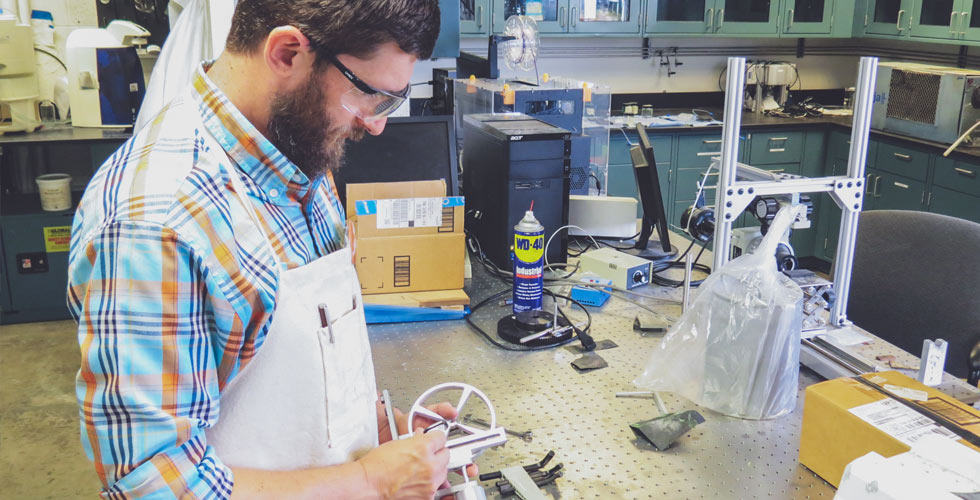The lab is currently funded by a variety of sponsors from industry and government sources. Major automotive manufacturers, the National Science Foundation, the Department of Energy, Oak Ridge National Lab and material suppliers form the core support of the lab.
Battery electric systems (ground vehicles, aircraft, devices, and others) have a range of power and energy requirements. The EESCL is building a moderated, publicly-available, interactive Ragone plot that can be used to compare and identify batteries for a variety of applications. Visitors may submit a battery’s performance metrics (e.g. power and energy density) along with support (e.g. a peer-reviewed publication, sponsor report) and it may be an entry on this plot for others to discover.
RFBs are emerging as a companion technology to sustainable energy sources like wind and solar power. The FBDDL is pioneering diagnostic approaches that enable fundamental understanding of the processes that drive these systems. With both experimental and simulation-based approaches, the lab is solving problems that limit the lifetime and performance of RFBs.
BES are capable of directly converting organic waste into electricity or hydrogen gas. In collaboration with Chemical and Biomolecular Engineering partners, we are investigating platinum group metal-free catalysts, both experimentally and via computer modeling.
The EESCL has extensive experience related to observed multi-phase phenomenon to stability and degradation in PEFCs. Ongoing research involves a wide range of technologies including neutron imaging, direct visualization, computational modeling, and a multitude of materials analysis techniques.
The group has developed expertise and collaborative relationships with the staff at the NIST Center for Neutron Research. Demonstrated capabilities include neutron imaging investigations into RFB parasitic reactions, PEFC water formation and motion, and 3-D computed tomography of water freeze-thaw cycling.
The EESCL has completed a multi-year program funded by NSF to directly visualize and quantify liquid water fluid dynamics in micro-channels and through the diffusion media for Direct Methanol Fuel Cell and hydrogen PEFC applications.
All diagnostics developed by the EESCL have a unique real-time capability. These are being combined to study the actual current, species, and impedance dynamics of the PEFC under realistic load cycling, a condition quite different than typically-studied fuel cell statics. Results are being incorporated into models developed to describe operation under these conditions for fuel cell online control.
New open flow field architectures pioneered by Nuvera were modeled and tested at the EESCL. At up to 3A/cm2, extreme transport gradients occur and are being studied for the first time.
The online species and temperature diagnostics that have been developed at the EESCL are being applied to determine more accurate transport parameters for mass and heat in the diffusion media. This enables more accurate modeling results and predictive capabilities
The EESCL is developing online, in situ sensors to detect and quantify long-term failure modes (such as catalyst migration and degradation or pinhole formation) at an early stage so that mitigation strategies can be applied to prolong life. These sensors utilize tools of symbolic dynamics and the dynamic response of the fuel cell to an external stimulus to rapidly quantify the long-term degradation level. This technology has recently been applied to develop a precise Online Carbon Monoxide Poison Sensor to accurately quantify CO poisoning to the ppm level. This enables a much more robust fuel cell system and eliminates expensive CO sensor hardware.
The EESCL is constantly developing advanced diagnostics to measure important fuel cell phenomena. Current examples include MEMS-based thermal sensors and flow sensing to determine local diffusion media bypass. We are also always interested in teaming with other partners who seek to apply new technology to PEFCs.
The FCDDL and FBDDL have years of experience developing high fidelity modeling tools to help design materials and understand multi-phase phenomena in electrochemical power systems.
Researchers at the APL with FCDDL have developed an electrochemically based method to safely convert a major class of hazardous gas-phase waste into an easy to dispose of product. This approach is significantly less expensive than conventional disposal means.
The EESCL has several years experience in the development of advanced DMFC and DAFC designs for portable power applications. Research is ongoing.
